Basic Information
-
mRNA expression analysis

-
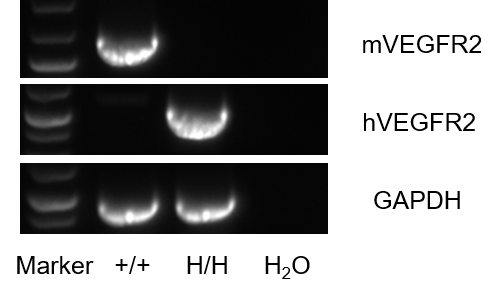
Species-specific VEGFR2 gene expression analysis in wild-type and humanized B-hVEGFR2 mice by RT-PCR.
Murine Vegfr2 mRNA was detected in embryonic tissue isolated from wild-type (+/+) mice, while human VEGFR2 mRNA was exclusively detected in homozygous B-hVEGFR2 (H/H) mice. -
Protein expression analysis

-
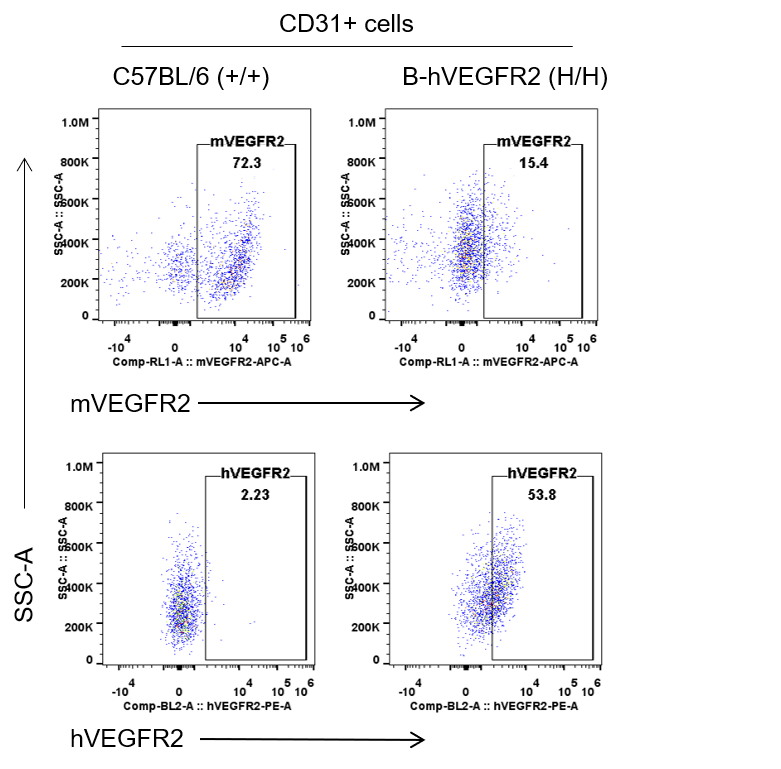
Species-specific VEGFR2 protein expression analysis in wild-type and humanized B-hVEGFR2 mice. Embryonic lung endothelial cells were isolated from wild-type C57BL/6 (+/+) and homozygous B-hVEGFR2 (H/H) mice and analyzed by flow cytometry using anti-VEGFR2 antibodies. Human VEGFR2 protein was exclusively detected in B-hVEGFR2 mice.
-
Analysis of spleen

-
Analysis of spleen leukocytes cell subpopulations in B-hVEGFR2 mice
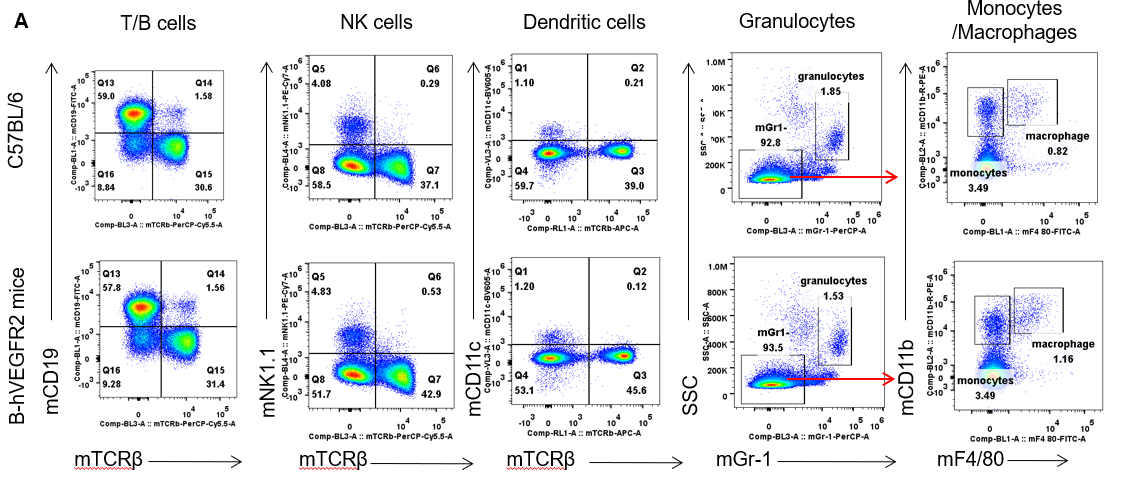

Analysis of spleen leukocyte subpopulations by FACS. Splenocytes were isolated from female C57BL/6 and B-hVEGFR2 mice (n=3, 6-week-old). Flow cytometry analysis of the splenocytes was performed to assess leukocyte subpopulations. A. Representative FACS plots. Single live cells were gated for the CD45+ population and used for further analysis as indicated here. B. Results of FACS analysis. Percent of T cells, B cells, NK cells, dendritic cells, granulocytes, monocytes and macrophages in homozygous B-hVEGFR2 mice were similar to those in the C57BL/6 mice, demonstrating that VEGFR2 humanized does not change the overall development, differentiation or distribution of these cell types in spleen. Values are expressed as mean ± SEM.
Analysis of spleen T cell subpopulations in B-hVEGFR2 mice

Analysis of spleen T cell subpopulations by FACS. Splenocytes were isolated from female C57BL/6 and B-hVEGFR2 mice (n=3, 6-week-old). Flow cytometry analysis of the splenocytes was performed to assess leukocyte subpopulations. A. Representative FACS plots. Single live CD45+ cells were gated for TCRβ+ T cell population and used for further analysis as indicated here. B. Results of FACS analysis. The percent of CD4+ T cells, CD8+ T cells, and Tregs in homozygous B-hVEGFR2 mice were similar to those in the C57BL/6 mice, demonstrating that VEGFR2 humanized does not change the overall development, differentiation or distribution of these T cell subtypes in the spleen. Values are expressed as mean ± SEM.
-
Analysis of Lymph Node

-
Analysis of lymph node leukocytes cell subpopulations in B-hVEGFR2 mice
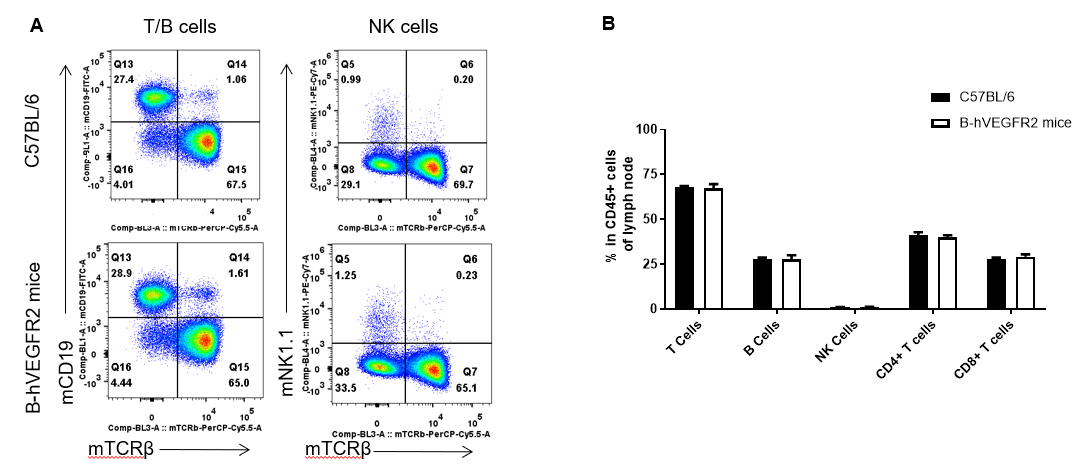
Analysis of lymph nodes leukocyte subpopulations by FACS. Lymph node was isolated from female C57BL/6 and B-hVEGFR2 mice (n=3, 6-week-old). Flow cytometry analysis of the leukocytes was performed to assess leukocyte subpopulations. A. Representative FACS plots. Single live cells were gated for the CD45+ population and used for further analysis as indicated here. B. Results of FACS analysis. Percent of T cells, B cells, NK cells in homozygous B-hVEGFR2 mice were similar to those in the C57BL/6 mice, demonstrating that VEGFR2 humanized does not change the overall development, differentiation or distribution of these cell types in the lymph node. Values are expressed as mean ± SEM.
Analysis of lymph node T cell subpopulations in B-hVEGFR2 mice

Analysis of lymph nodes T cell subpopulations by FACS. Lymph node was isolated from female C57BL/6 and B-hVEGFR2 mice (n=3, 6-week-old). Flow cytometry analysis of the leukocytes was performed to assess leukocyte subpopulations. A. Representative FACS plots. Single live CD45+ cells were gated for TCRβ+ T cell population and used for further analysis as indicated here. B. Results of FACS analysis. The percent of CD4+ T cells, CD8+ T cells, and Tregs in homozygous B-hVEGFR2 mice were similar to those in the C57BL/6 mice, demonstrating that VEGFR2 humanized does not change the overall development, differentiation or distribution of these T cell subtypes in the lymph node. Values are expressed as mean ± SEM.
-
Analysis of blood

-
Analysis of blood leukocytes cell subpopulations in B-hVEGFR2 mice

Analysis of blood leukocyte subpopulations by FACS. Blood was isolated from female C57BL/6 and B-hVEGFR2 mice (n=3, 6-week-old). Flow cytometry analysis of the blood was performed to assess leukocyte subpopulations. A. Representative FACS plots. Single live cells were gated for the CD45+ population and used for further analysis as indicated here. B. Results of FACS analysis. Percent of T cells, B cells, NK cells, dendritic cells, granulocytes, monocytes and macrophages in homozygous B-hVEGFR2 mice were similar to those in the C57BL/6 mice, demonstrating that VEGFR2 humanized does not change the overall development, differentiation or distribution of these cell types in the blood. Values are expressed as mean ± SEM.
Analysis of blood T cell subpopulations in B-hVEGFR2 mice
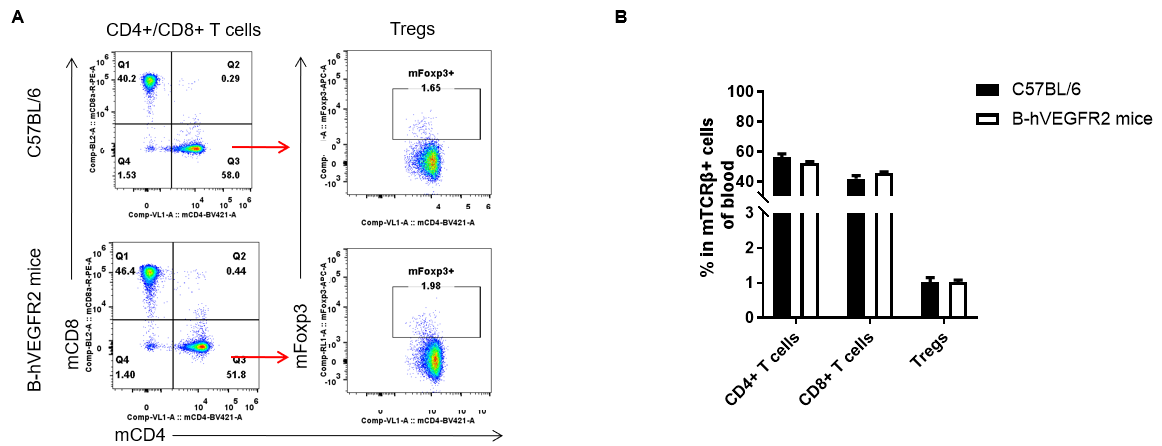
Analysis of blood T cell subpopulations by FACS. Blood was isolated from female C57BL/6 and B-hVEGFR2 mice (n=3, 6-week-old). Flow cytometry analysis of the blood was performed to assess leukocyte subpopulations. A. Representative FACS plots. Single live CD45+ cells were gated for TCRβ+ T cell population and used for further analysis as indicated here. B. Results of FACS analysis. The percent of CD4+ T cells, CD8+ T cells, and Tregs in homozygous B-hVEGFR2 mice were similar to those in the C57BL/6 mice, demonstrating that VEGFR2 humanized does not change the overall development, differentiation or distribution of these T cell subtypes in the blood. Values are expressed as mean ± SEM.
-
In vivo efficacy of an anti-human VEGFR2 antibody

-

Antitumor activity of an anti-human VEGFR2 antibody in humanized B-hVEGFR2 mice. Murine colon cancer MC38 cells were subcutaneously implanted into homozygous B-hVEGFR2 mice (female, 8-week-old, n=6), when the tumor volume reached ~100 mm3, mice were treated with an anti-human VEGFR2 antibody (Ramucirumab, in house). (A) Ramucirumab treatment inhibited MC38 tumor growth in B-hVEGFR2 mice, (B) without negatively impacting body weight changes. Values are expressed as mean ± SEM.
-
Poster

-
AACR 2023: In vivo Efficacy Evaluation of Anti-Human VEGFR2 Antibodies in Humanized B-hVEGFR2 Mice


